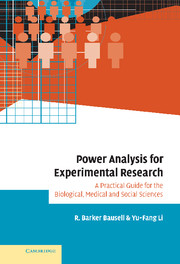 Power Analysis for Experimental Research
Power Analysis for Experimental Research Book contents
- Frontmatter
- Contents
- Introduction
- 1 The conceptual underpinnings of statistical power
- 2 Strategies for increasing statistical power
- 3 General guidelines for conducting a power analysis
- 4 The t-test for independent samples
- 5 The paired t-test
- 6 One-way between subjects analysis of variance
- 7 One-way between subjects analysis of covariance
- 8 One-way repeated measures analysis of variance
- 9 Interaction effects for factorial analysis of variance
- 10 Power analysis for more complex designs
- 11 Other power analytic issues and resources for addressing them
- Technical appendix
- Bibliography
- Index
1 - The conceptual underpinnings of statistical power
Published online by Cambridge University Press: 28 August 2009
- Frontmatter
- Contents
- Introduction
- 1 The conceptual underpinnings of statistical power
- 2 Strategies for increasing statistical power
- 3 General guidelines for conducting a power analysis
- 4 The t-test for independent samples
- 5 The paired t-test
- 6 One-way between subjects analysis of variance
- 7 One-way between subjects analysis of covariance
- 8 One-way repeated measures analysis of variance
- 9 Interaction effects for factorial analysis of variance
- 10 Power analysis for more complex designs
- 11 Other power analytic issues and resources for addressing them
- Technical appendix
- Bibliography
- Index
Summary
The importance of statistical power
As currently practiced in the social and health sciences, inferential statistics rest solidly upon two pillars: statistical significance and statistical power. The two concepts, both of which are expressed in terms of probabilities (i.e., how likely events are to occur), are so integrally related to one another that it is almost impossible to consider them separately.
Statistical significance, the first pillar, is a probability level generated as a byproduct of the statistical analytic process. It is computed after a study is completed and its data are collected. It is used to estimate how probable the study's obtained difference or relationship (which is called its effect size) would be to occur by chance alone. Based in large part upon Sir Ronald Fisher's (1935) recommendations, this probability level is often interpreted as an absolute standard. If it is 0.05 or below, the results are said to be statistically significant and the researcher has, by definition, supported his/her hypothesis. If it is 0.06 or above, then statistical significance is not obtained and the research hypothesis is not supported.
Statistical power, on the other hand, is computed before a study's final data are collected. It involves a two-step process: (a) hypothesizing the effect size which is most likely to occur based upon the study's theoretical and empirical context and (b) estimating how probable the study's results are to result in statistical significance if this hypothesis is correct.
- Type
- Chapter
- Information
- Power Analysis for Experimental ResearchA Practical Guide for the Biological, Medical and Social Sciences, pp. 1 - 15Publisher: Cambridge University PressPrint publication year: 2002


